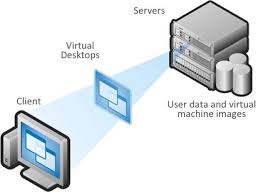VDI Solutions: Uniting Performance, Scalability, and Cost-Efficiency
 Like many organizations, your foray into cloud computing may have started with an ancillary or security service, like email spam and virus protection. For some, the first or second step into the cloud was moving email off-premise. For others, a cloud-based CRM service or VDI solution was the first application in the cloud.
Like many organizations, your foray into cloud computing may have started with an ancillary or security service, like email spam and virus protection. For some, the first or second step into the cloud was moving email off-premise. For others, a cloud-based CRM service or VDI solution was the first application in the cloud.
Currently, we see organizations rapidly moving file services and storage into cloud-based solutions as more marketing, sales, and line of business applications switch to Software-as-a-Service (“SaaS”) or SaaSOps solutions. Often, this leaves you with a small set of business applications running on-premise.
VDI Solutions Explained
What do you do with applications and services left on-premise when most of your systems have moved, or will be moving, to the cloud?
While you may wish to keep these legacy systems on-premise, you can move them into a cloud or hosted Virtual Desktop Infrastructure (VDI) environment. VDI environments provide a virtualized, remote desktop accessible via browser or “receiver” app. When connected, users get their full desktop environment with access to local and network applications.
Some applications, such as computer-aided design (CAD) and manufacturing/process controls, are not well-suited for VDI. Most local and network applications work well within a VDI environment. VDI services typically charge based on processor load, memory, and allocated disk space. Fees may also include standard office software, data backup services, malware protection, and other common network services.
Why use VDI Solutions?
- Improved secure accessibility to legacy applications, particularly for remote and mobile users
- Lower cost for IT and cloud infrastructure, especially when email, apps, and other services are moving to the cloud
- Improved reliability and security, as VDI solutions run in professionally managed data centers
- IT resources are free to work on higher value projects than maintaining core infrastructure and services
- Lower cost and less administration of end-user devices, as you can move to thin clients, chromebooks, and tablets as existing desktops and laptops need replacing
When to use a VDI Solution?
For some small and mid-size enterprises, VDI solutions provide a means to “clean out the closet”, to simplify their IT solutions and walk away from endless maintenance and updates. For others, a VDI solution enables them to move legacy systems and applications to a cloud-based environment.
When considering a VDI service for legacy applications and systems, answering a few basic questions while help you determine if your “when” is “now”.
- Is the application is available in a Software-as-a-Service (Saas) subscription?
- Does the application have custom modules or code that would prevent running the SaaS version?
- Are application requirements — processor power, memory, disk space — known and understood?
- How many users need access to the application?
- How many users receive reports or data from the application?
- What connections or integrations exist between local/network applications?
With answers to these questions, you can scope the size and configuration of your VDI environment. You can also assess if the benefits, and the costs, of a VDI solution outweigh the costs and effort required to maintain the systems on-premise.
As you move applications and services to the cloud, you will likely reach a point where you no longer have the critical mass necessary for on-premise servers to be the most economical and effective solution. When you reach this tipping point, a VDI solution will provide a secure home for your systems, your business, and your budget.



